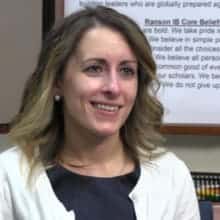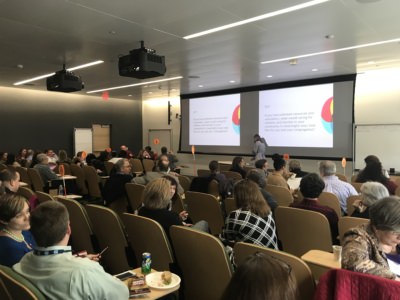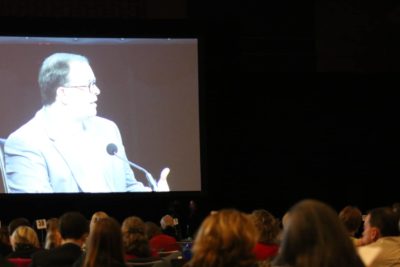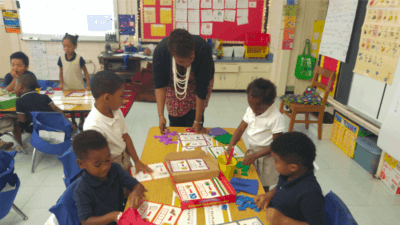MCL Whelan: Is there a specific part of the Opportunity Culture model that stands out to you?
Principal Jordan-Thomas: I think just the innovative approach to expanding the impact of great teachers like yourself. We have about 50 percent of our staff that’s in years one through four, and it’s honestly disappointing that [most educators] still haven’t changed the reality of a first-year teacher. Why are we putting the burden of figuring out how to break down standards, create an exemplar lesson plan, on a first-year teacher, in addition to managing a classroom, contacting parents, turning in the blue cards to the front office—there’s this long to-do list, and we know that there are certain things that great teachers have to do; why aren’t we scaffolding that over their tenure as a teacher? That’s what Opportunity Culture allows us to do—have great teachers in the building who know what great teaching looks like. We are rethinking what responsibilities [for beginner and veteran teachers] look like, creating something that’s sustainable in terms of teaching in an environment that just has so many high demands. We are progressing towards making this something that you can do for more than two years, or three or four years—we’re creating that pathway.
MCL Whelan: With all this greatness comes challenges, like the issue of long-term subs or teachers leaving in the middle of the year for a variety of reasons. How does the MCL model help?
Principal Jordan-Thomas: There are some times where I’ve learned as a principal that I’m okay with losing a staff member that’s not a fit, before June. So the reality of that is, as a multi-classroom leader you have to shift your responsibilities and shift your support, because now you might be dealing with a content gap, when before you may not have had that because it might have been a certified teacher. I think the way that Opportunity Culture allows us to be able to get in front of that challenge is being able to step into a classroom with kids who have a long-term sub and seeing them online, hearing the voice of an MCL [through online instruction developed just for them]. So they’re still receiving quality instruction, and this long-term sub, they don’t have to carry this burden by themselves of figuring out the content and lesson plans—that’s where the MCL can lean in and support.
MCL Whelan: What are some supports that are put into place for the MCL when teachers leave?
Principal Jordan-Thomas: Even though you guys [MCLs] are master teachers, we try not to default to you going into the classroom and being the teacher, because it’s limiting your impact with your pod of teachers as a whole. We’ve leveraged online learning and blended learning—it might be you pushing in for half of the block and the other half of the block the kids are online doing practice. Then, the long-term sub can go around and assist scholars. So I think that’s a huge part, getting innovative with some of the instructional planning.
I was in this situation my first two years as an MCL, and again this year, so I know firsthand the frustration and challenges it creates. While it puts a greater burden on MCLs and increases their work load, having an MCL is what allows a team to still succeed. My team would not have been able to exceed our expected student growth those two years had I not have been there as an MCL to help close gaps. “Finding the third way,” a core Ranson value, was one I lived out every day. I used blended learning and made daily videos for those scholars, tailored to what they would have received if they had a full-time teacher. If I had not put in the extra work and hours, we (I) would have failed our scholars—and I could not have let that happen.
MCL Whelan: When teachers leave or we have long-term subs the whole year, where would the teachers and the scholars be if Opportunity Culture was not here at Ranson?
Principal Jordan-Thomas: I think we would still be spinning our wheels. Opportunity Culture allows for a teacher [or a team with a vacancy] to have the support that they deserve, because the structure of a school should not prevent a teacher in growing professionally.
MCL Whelan: For other principals interested in this model, and policymakers, what would you say to them about being a principal with Opportunity Culture at your school?
Principal Jordan-Thomas: It is something that every principal should consider from a people standpoint, of ‘how are we expanding the opportunities that teachers have to continue to grow in the profession?’ I say this is in the best interest of kids, because you’re ensuring that every kid has access to high-quality instruction. People who are great teachers though are not necessarily great coaches, and so what does that look like from the interview process, what does that look like in terms of ongoing professional development? It requires more than just creating the position. As much as this lives and breathes the philosophy of ongoing professional development for teachers, that same philosophy has to exist through every level—so MCLs need ongoing professional development, too, and there has to be a strategic system in place for that.
View a video of our conversation here.
To learn more, watch a TEDxCharlotte talk by Jordan-Thomas about her work at Ranson; see also the findings of a new study by the American Institutes for Research and the Brookings Institution of the effect of Opportunity Culture on student academic gains.





